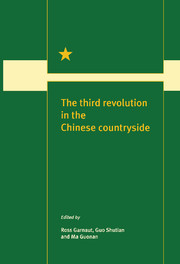Book contents
- Frontmatter
- Contents
- Figures
- Maps
- Tables
- Contributors
- Preface
- 1 The third revolution
- Feeding the people
- 2 Success in early reform: setting the stage
- 3 Completing the third revolution
- 4 China's grain demand: recent experience and prospects to the year 2000
- 5 Rural poverty in post-reform China
- Marketing and price reform
- Internationalisation
- Regional issues
- Institutional change
- References
- Index
4 - China's grain demand: recent experience and prospects to the year 2000
from Feeding the people
Published online by Cambridge University Press: 04 August 2010
- Frontmatter
- Contents
- Figures
- Maps
- Tables
- Contributors
- Preface
- 1 The third revolution
- Feeding the people
- 2 Success in early reform: setting the stage
- 3 Completing the third revolution
- 4 China's grain demand: recent experience and prospects to the year 2000
- 5 Rural poverty in post-reform China
- Marketing and price reform
- Internationalisation
- Regional issues
- Institutional change
- References
- Index
Summary
The massive structural reform of the Chinese grain sector through the 1980s and 1990s is continuing. The years 1991 and 1992 marked an historical turning point in China's market-oriented reform when for the first time the government removed the massive subsidy on urban grain supply and most of the controls on grain marketing. By the end of 1993 the mechanisms for state procurement and allocation by coupon had been removed in more than 90 per cent of mainland China's 30 provinces. For the first time in the PRC's history, government control over the grain sector, a core element of the old plan system, was broken.
The Chinese grain sector, like other parts of the national economy, has experienced various cycles of reform since 1978 (Li, Watson and Findlay, chapter 16). There has been inevitable pressure for re-control in response to market outcomes – for example, those generated by the sharp price increases from December 1993. The dismantling of some of the old institutions of control in 1991–3, however, places limits on the reversal of the recent reforms. More importantly, there is a logic to increased market orientation in the grain sector that becomes evident in practice and which therefore constrains the cycle of reform.
- Type
- Chapter
- Information
- The Third Revolution in the Chinese Countryside , pp. 38 - 62Publisher: Cambridge University PressPrint publication year: 1996



